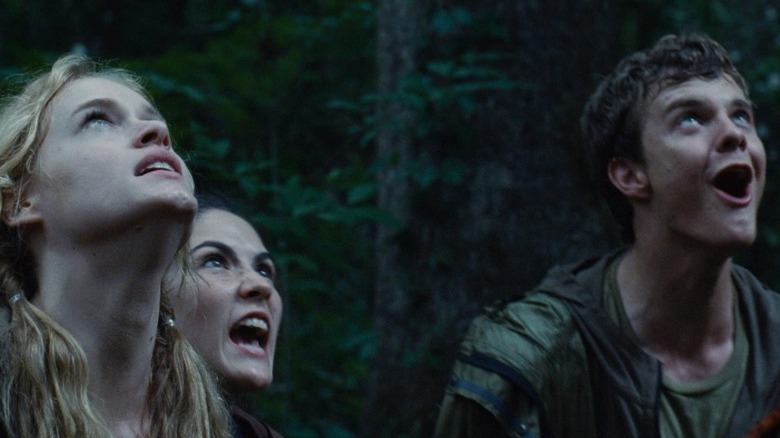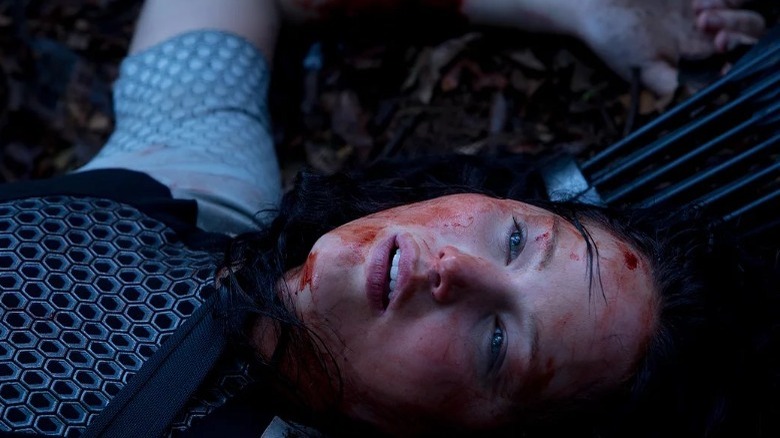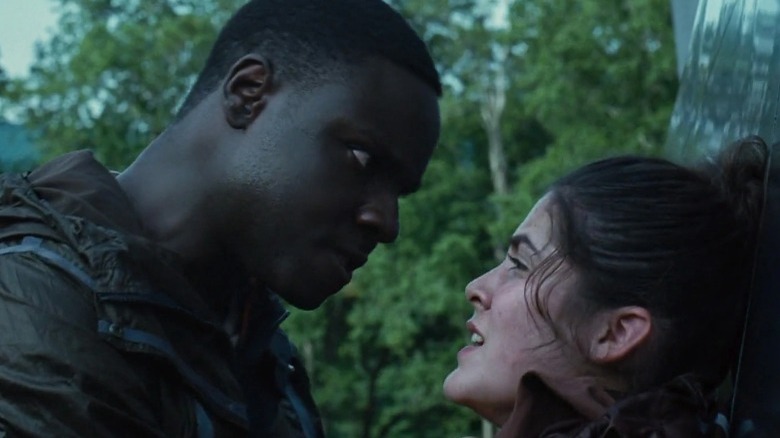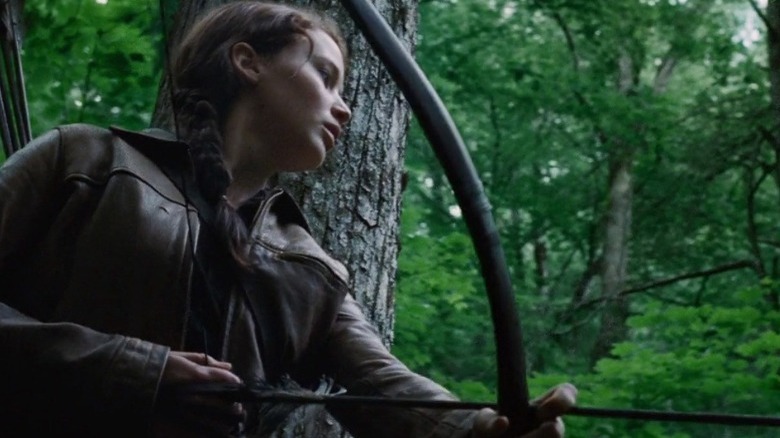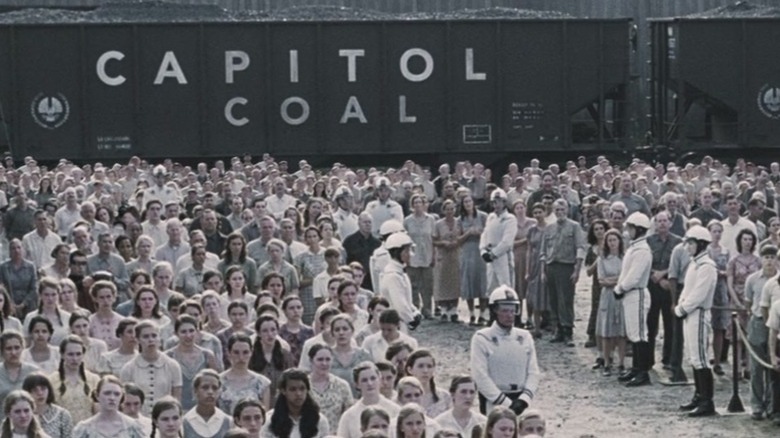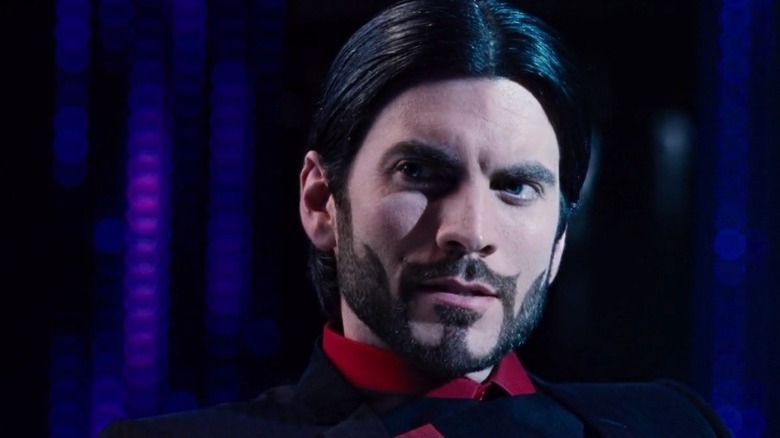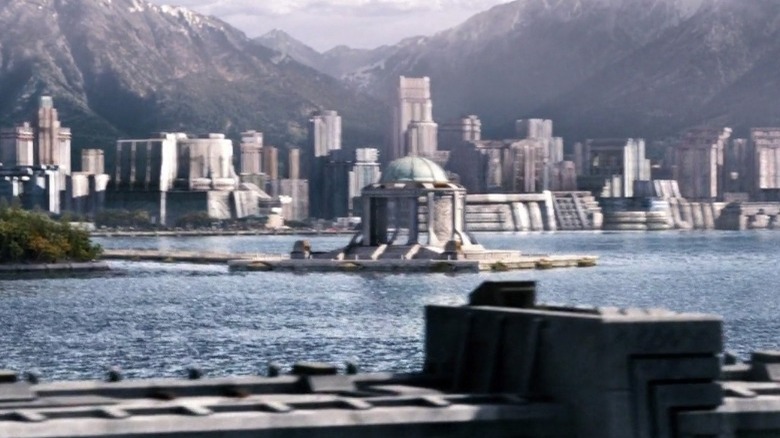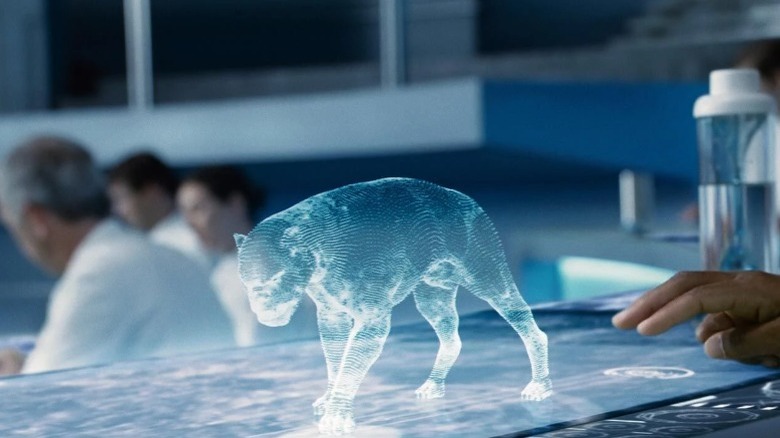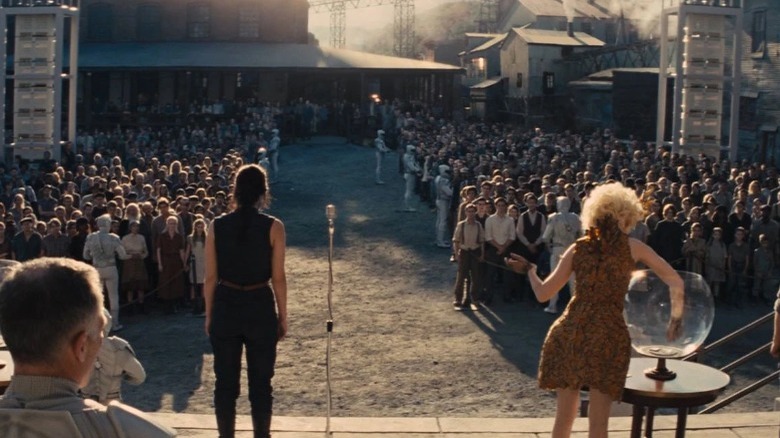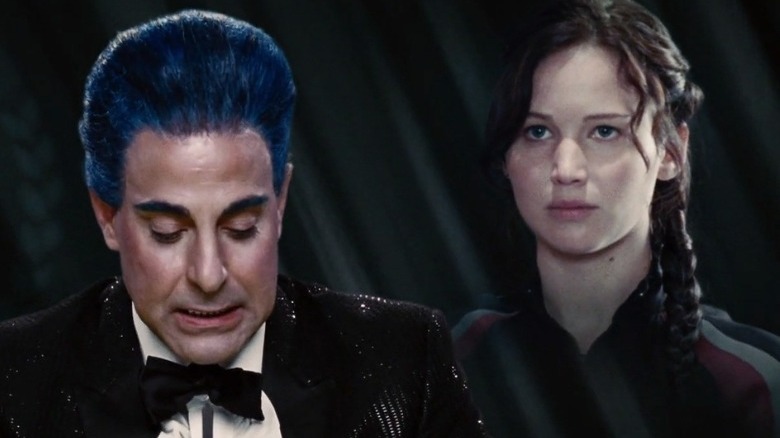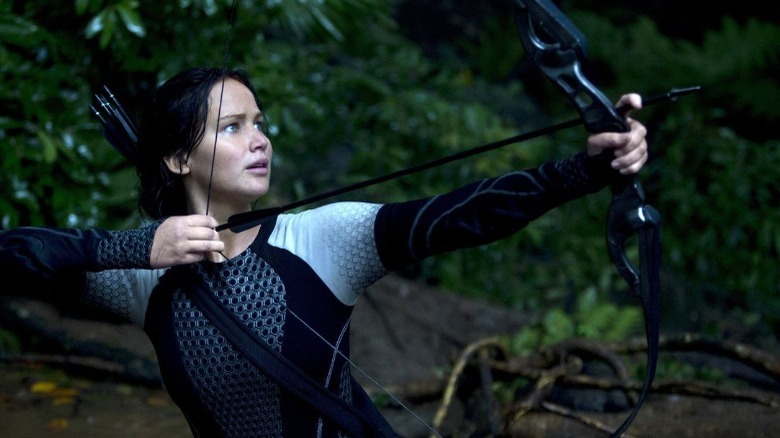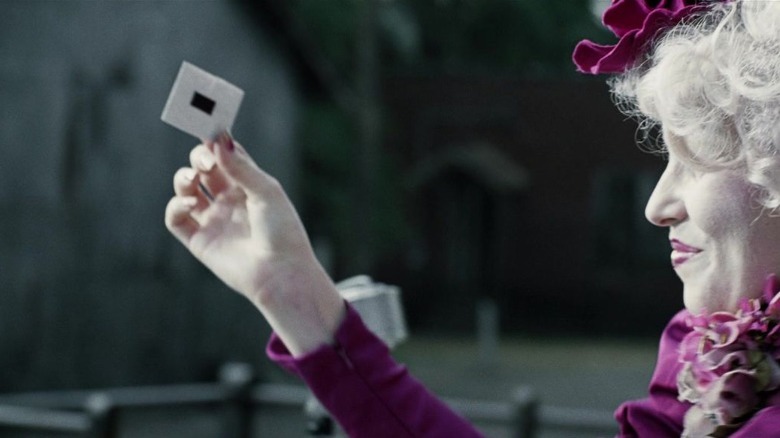The Biggest Plot Holes In The Hunger Games Franchise
Since its introduction in 2008, Suzanne Collins' "The Hunger Games" series has become one of the most successful modern book franchises. As well as the numerous sequel novels, it also led to a film adaptation series that now includes five movies following the release of the prequel "The Hunger Games: The Ballad of Songbirds & Snakes."
Set in a dystopian future where the powerful and affluent Capitol controls the downtrodden citizens of 12 districts, the eponymous annual event sees randomly selected "tributes" forced to fight to the death for entertainment. An ensemble cast that includes Jennifer Lawrence, Woody Harrelson, and Liam Hemsworth, brought the action to life on screen in brilliant fashion and helped make the franchise an unprecedented success.
Like any film narrative that involves multiple entries, "The Hunger Games" franchise has its fair share of plot holes. With so many things going on, it is understandable that some of them don't make sense and fans have noticed some of these glaring problems in the movies released so far. Here are some of the biggest plot holes in "The Hunger Games" franchise.
Why were more Districts not training volunteers?
While tributes in "The Hunger Games" are normally chosen during an event known as the reaping, there is another way for someone else to take on the responsibility. Volunteers essentially put themselves forward to replace the original tribute. Most often, volunteers are close family or friends of the tribute and offer to take their place out of love — as we see Katniss (Jennifer Lawrence) stepping in to replace younger sister Prim (Willow Shields) — however, that is not always the case. While volunteers are rare, there are a select few districts that specifically train volunteers from a young age to be equipped to compete in the games. This makes them highly effective fighters and gives them a much better chance of surviving and winning the competition.
This does beg the question: Why don't all of the districts train volunteers? The practice is technically against the rules of the games, but Districts One and Two seemingly do this without suffering any punishment. The Hunger Games come with a lot of danger but provide one of the only ways to escape poverty and provide for their families, something that many might well be willing to do. Yet, only a small number of districts train volunteers, and the reason for this isn't necessarily something that is explored in detail.
Peeta's impossible rock disguise
Alongside Katniss, Peeta Mellark (Josh Hutcherson) is one of the protagonists in "The Hunger Games" film franchise. Both hailing from District 12, the pair work together to survive the games and eventually become romantically involved as their relationship deepens. Peeta is the son of a baker — particularly skilled at decorating cakes — and he uses this skill for what is arguably one of the most ridiculous moments in the entire series.
While competing in the 74th Hunger Games, Peeta is injured and is largely unable to move after Cato (Alexander Ludwig) stabs him in the leg. Vulnerable to further attacks and not able to protect himself in combat, Peeta decides that hiding is the best option and disguises himself as a rock using mud and other natural materials he can find. The result is hilarious and nonsensical, with even Hutcherson finding the experience funny. When you think about it, such a disguise should have been impossible — even for someone so skilled at decorating desserts — and making it so realistic would have required an entire special effects team.
The wire should not have stopped unspooling
In the grand scheme of things, this plot hole might not seem like a major continuity error that has a large effect on the overall plot of "The Hunger Games: Catching Fire." Yet, the spool of wire that Katniss is unspooling across the mountain from a tree to the shoreline as a trap against the competing tribe ultimately plays a vital part in the plot. After all, without the wire, Katniss would not have been able to attach an arrow to it and then use it to break the force field when lightning strikes and electricity shoots along the wire.
The plot hole itself has to do with how the wire suddenly becomes tight and stops unspooling as Katniss is laying it. Despite her best efforts to get the wire to continue to unspool, it won't budge and stays tight as someone on the other end pulls it at the same time. Of course, this doesn't make any sense as Katniss should still have been able to lay the wire as it would be loose on her end and easily unspool even if someone was tugging on the other end. The plotholes in "Catching Fire" haven't gone unnoticed, with Reddit user u/Racoonie commenting "That movie had plotholes so big, you could drive another movie through it."
Thresh shouldn't have known about Katniss and Rue
In the first "Hunger Games" film, the two tributes from District 11 are Thresh (Dayo Okeniyi) and Rue (Amandla Stenberg). While Thresh is a formidable opponent with outstanding strength and fighting abilities, Rue is a smaller and gentler figure who eventually allies with Katniss. The pair work together to survive in the arena during the 74th Hunger Games and become fast friends even though they are technically enemies. Katniss is emotionally devastated by Rue's death and avenges her not long afterward.
Later in the movie, Katniss is cornered and attacked by Clove (Isabelle Fuhrman) but is saved by Thresh. He kills Clove and spares Katniss, claiming that her friendship with Rue is the reason and that the pair are now even. However, it isn't clear exactly how Thresh knows Katniss helped Rue so much. Although he overhears the conversation where Clove teases Katniss about Rue's death, very little information is given away at this time. In the book, Thresh questions Katniss about what Clove meant, but this doesn't happen in the movie, leaving an open question over exactly what Thresh knew and how.
How Katniss can shoot down bombers
Throughout "The Hunger Games" franchise Katniss' main weapon of choice is her trusty bow and arrow. The character is a skilled archer who honed her skills by hunting for food outside District 12 while she was a child. In the movies, Katniss uses the bow almost exclusively once she acquires it from Glimmer (Leven Rambin) early on during the 74th Hunger Games. From there, the bow and arrow give Katniss a way to source food for her and her allies as well as dispatch her enemies. She uses it to kill the likes of Marvel (Jack Quaid) and Cato (Alexander Ludwig), demonstrating just how deadly she is.
In "The Hunger Games: Mockingjay – Part 1," Katniss is supplied with a far more advanced weapon that works with several different types of arrows, including explosive and incendiary arrows. This new bow also comes equipped with gadgetry, but none of this explains just how she is capable of shooting down fast-moving bombers that should be armored against explosives. While the hovercraft is not as fast as fighter jets, they still should not be able to be hit by an arrow shot by a bow from such a considerable distance, as shown when the bombers attack the District 8 hospital and are destroyed by Katniss.
The coal mines seem almost completely pointless
District 12 is arguably the poorest district in "The Hunger Games" and its citizens face a constant battle against both poverty and malnutrition. Like the other districts, it has a specialist industry that it operates to provide goods and services to the Capitol. In the case of District 12, the area focuses on coal mining as a way of generating energy for the Capitol, something that is said to be essential but is evidently not. In fact, from what viewers get to see in "The Hunger Games" films, the coal mines in District 12 may be entirely pointless.
First of all, District 5 is said to be the region that generates and then supplies electricity to the Capitol and the other districts, with many power plants operating within it. The mining operation itself is also rather inefficient, largely relying on individuals rather than machinery to extract the coal. At one point, the Capitol even shuts off the mines for two weeks and then carpet bombs the entire district. This permanently destroys the mines, and is in retribution for Katniss escaping from the arena during the 75th Hunger Games, proving they are not needed. Why the coal mines continue to operate without a definitive purpose is something that isn't made clear.
The Games wouldn't prevent rebellion
The entire point of the Hunger Games in the franchise is that they act as both a deterrent against rebellion and a punishment for a previous uprising. Long before the events of the movies, the 13 districts rose up against the Capitol and engaged in a war that eventually saw the rebels mercilessly put down by the Capitol's forces and District 13 becoming an independent nation. The Capitol then sets up the Hunger Games in order to remind everyone that it holds all the power and as a way of instilling fear in the population of the remaining districts.
Fans have noted, however, that this is something of a plot hole. While the removal of two children who are then forced to fight to the death against others is frightening, it would not work as an effective way of suppressing rebellion. As noted in The New Yorker, stealing away children and having them be subject to such torturous conditions would likely lead to parents starting a rebellion to stop it from happening in the future, especially when there's nothing else they can do to prevent their children from being randomly selected. Considering that, the Hunger Games make little sense as they would be more likely to make people join a rebel cause after watching their friends and family constantly be slaughtered.
The Capitol shouldn't need the Districts
The Capitol is the ruling region of Panem, a futuristic version of the United States that has been decimated. Surrounding it are 12 districts, each with unique industries that they are forced to operate to provide for the needs of the Capitol and its people. District 12 is a coal mining region, while District 1 provides luxury items, and District 4 is responsible for fishing to provide seafood. According to the films, the Capitol maintains its wealth by subjugating the districts and forcing them to work on their behalf.
Yet, it isn't really clear that the Capitol needs the districts at all and it seems that its advanced technology means it no longer has to rely on the materials the districts can offer. The Capitol is filled with futuristic gadgets, extravagant clothing, and far superior technology, such as hovercrafts. With all of that, relying on the districts for things like coal, lumber, and meat seems unnecessary, as they should either no longer be using such base materials or be able to automate their production. Historically, the Capitol may have needed the resources of the districts, but now it could be the case that they're just using them to assert their dominance.
Where do the dogs come from?
For tributes competing in the arena of the Hunger Games, life is not easy. Not only do they have to compete against each other, but they also have to face off against numerous threats. This includes a wide selection of traps, natural hazards, and "muttations." These mutts are genetically altered creatures that prowl the arena and can seemingly be introduced by the Gamemakers at any time to spice up the action.
One of these muttations is a group of wild dogs, which are much larger and more dangerous than domesticated dogs. They first appear in the original movie, although their sudden arrival in the arena has raised some eyebrows. Fans have noted how they seemed to just show up out of nowhere, almost as if they had materialized out of thin air when the Gamemakers decided to release them upon Katniss and her allies. There are other similar instances as well, such as when trees or other items suddenly appear without warning, opening up the question about how exactly this happens. It is clear the purpose is to make it even more difficult for the tributes, but the mechanics of how this is achieved are hazy.
The lack of names in the Reaper Bowl
One of the most often cited plot holes for "The Hunger Games" is that the glass bowl used in the Reaping each year is far too small to hold all of the names of the eligible tributes. So where are all the other ballots and why are the reaping bowls not an accurate representation of the eligible populations for each district?
There are no confirmed stats about the population numbers of any of the districts or even the Capitol outside of District 12, which we know has around 10,000 living in it. But knowing that District 12 is also known to be the smallest and least valuable district in Panem, it is likely that the other regions have significantly larger populations. Yet, even taking just District 12 as an example leads to problems. Even if less than a third of people in a region are of reaping age, that would mean thousands of names being in the bowl — especially when you consider that the older children receive more entries and individuals can voluntarily enter their name more times to gain food for their families.
There is no way to guarantee a sole winner
The Hunger Games is an annual event where two tributes battle it out to be the sole survivor. Think "Battle Royale" but on a much smaller but no less brutal scale. Those taking part also have to face other challenges, such as mutated creatures and obstacles and can receive sponsorship from wealthy individuals to gain advantages over their fellow competitors.
The end goal is to be the sole survivor, bringing themselves and their families untold wealth and food while also demonstrating to the populations of the districts what compliance can bring. The rules clearly state that there can be only one winner, although this is later altered to allow Peeta and Katniss to be declared joint winners. However, such is the unpredictability of the games, there is no way to guarantee that there will be any survivors after the conclusion of the Hunger Games. While the Gamemakers have some control over the events, it is certainly possible for the last remaining tributes to die at the same time due to an explosion, which would make the entire experience pointless.
Katniss' escape plan was too outlandish
Katniss and her allies eventually manage to escape from the arena during the events of "The Hunger Games: Catching Fire." Re-selected as tributes due to the Quarter Quell rule twist, Katniss and Peeta team up with several others to try and end the games and escape from the Capitol. At the end of the film, Katniss attaches a specially prepared wire to an arrow and shoots it into the roof of the dome that surrounds the arena just as lightning strikes, with the electricity from the bolt causing the force field to malfunction.
As a plan to escape, though, this scheme is simply too far-fetched. Katniss wasn't even aware of what the wire was for before shooting it and she not only managed to hit the exact spot she aimed for high above her head but timed it perfectly so that it would arrive at the same moment that the lightning hit the force field. If anything had gone wrong or the timing had been even fractionally off, the escape plan would have failed and the revolution stopped in its tracks.
Everyone should add their names to the bowl multiple times
The Hunger Games event can theoretically involve any child between the ages of 12 and 18 to be chosen as a tribute. However, certain individuals can become more likely to be randomly selected by entering their names multiple times. This happens in some respect automatically, with older children receiving more ballots than younger ones. However, it is also possible for a potential tribute to voluntarily increase their entries in exchange for food supplies in a system known as tesserae.
This means that those taking tesserae were far more likely to be chosen as a tribute during the Reaping. For example, Gale Hawthorne (Liam Hemsworth) was entered into the lottery 42 times during the events of the first film because of the rationing system. Of course, if everyone did this and entered their names multiple times, there would be no change in the chance of being chosen as the tribute for your district. The odds of being randomly selected would essentially remain unchanged but everyone would get extra food. If that is the case, then why doesn't every child do this as part of an organized effort to ensure everyone gets the food they need? This question remains unanswered, and perhaps it was the fear of the games — instilled by the Capitol — that led people to choose hunger over possible death.

